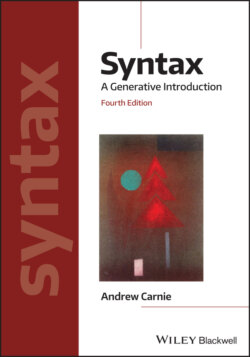Читать книгу Syntax - Andrew Carnie - Страница 33
2. THE MAJOR PARTS OF SPEECH: N, V, ADJ, AND ADV
ОглавлениеHaving determined that we are going to use distributional criteria for determining the part of speech of a word, we’ll now turn to some tests for particular lexical items. We’ll limit ourselves to the major classes of noun (N), verb (V), adjective (Adj), and adverb (Adv). We’ll look at other parts of speech in later sections.
One thing that you’ll notice is that these are specific to English. Every language will have its own distributional criteria. For each language linguists have to develop lists like the ones below.3
A final word of qualification is in order. Not every test will work in every situation, so it is usually best to use multiple morphological and syntactic tests for any given word if you can.
2.1 Nouns
Derivational Suffixes: In English, nouns often end in derivational endings such as -ment (basement), -ness (friendliness), -ity (sincerity), -ty (certainty), -(t)ion (devotion), -ation (expectation), -ist (specialist), -ant (attendant), -ery (shrubbery), -ee (employee), -ship (hardship),
-aire (billionaire), -acy (advocacy), -let (piglet), -ling (underling), -hood (neighborhood), -ism (socialism), -ing (fencing).
Inflectional Suffixes: Nouns in English don’t show much inflection, but when pluralized can take suffixes such as -s (cats), -es (glasses), -en (oxen), -ren (children), -i (cacti), -a (addenda).
Note that the following endings have homophonous usage with other parts of speech: -ing, -s, ‘s, -er, -en, but also sometimes are found on nouns.
Syntactic Distribution: Nouns often appear after determiners such as the, those, these (e.g., these peanuts), and can appear after adjectives (the big peanut). Nouns can also follow prepositions (in school). All of these conditions can happen together (in the big gymnasium). Nouns can appear as the subject of the sentence (we will define subject rigorously in a later chapter): The syntax paper was incomprehensible; or as the direct object: I read the syntaxpaper. Nouns can be negated by no (as opposed to not or un-): No apples were eaten.
One easy way to see if something is a noun is to see if you can replace it with another word that is clearly a noun. So if we want to see if the word people is a noun or not, we can substitute another word we know for sure to be a noun, e.g., John in I saw people running all over the place vs. I saw John running all over the place).
2.2 Verbs
Derivational Suffixes: Verbs often end in derivational endings such as -ate (dissipate), and -ize/-ise (regularize).
Inflectional Suffixes: In the past tense, verbs usually take an -ed or -t ending. In the present tense, third person singular (he, she, it), they usually take the -s ending. Verbs can also take an -ing ending in some aspectual constructions, (she was walking) and most take either an -en or an -ed suffix when they are passivized (more on passivization in later chapters): the ice cream was eaten.
Note that the following endings have homophonous usage with other parts of speech: -ing, -s, -en, -ed.
Syntactic Distribution: Verbs can follow auxiliaries and modals such as will, have, having, had, has, am, be, been, being, is, are, were, was, would, can, could, shall, should, may, must, and the special non-finite marker to. Verbs follow subjects, and can follow adverbs such as often and frequently. Verbs can be negated with not (as opposed to no and un-4).
2.3 Adjectives
Derivational Suffixes: Adjectives often end in derivational endings such as -ing (the dancing cat), -ive (indicative), -able (readable), -al (traditional), -ate (intimate), -ish (childish), - some (tiresome), -(i)an (reptilian), -ful (wishful), -less (selfless), -ly (friendly).
Inflectional Suffixes: Adjectives can be inflected into a comparative form using -er (alternately they follow the word more). They can also be inflected into their superlative form using -est (alternately they follow the word most). Adjectives are typically negated using the prefix un- (in its sense meaning “not”, not in its sense meaning “undo”).
Note that the following affixes have homophonous usage with other parts of speech:
-ing, -er, -en, -ed, un-, -ly.
Syntactic Distribution: Adjectives can appear between determiners such as the, a, these, etc. and nouns (the big peanut). They also can follow the auxiliary am/is/are/was/were/be/been/being (warning: this distribution overlaps with verbs). Frequently, adjectives can be modified by the adverb very (warning: this distribution overlaps with adverbs).
You now have enough information to try CPS1 & 2.
2.4 Adverbs
Derivational Suffixes: Many adverbs end in -ly: quickly, frequently, etc.
Inflectional Suffixes: Adverbs generally don’t take any inflectional suffixes. However, on rare occasions they can be used comparatively and follow the word more: She went more quickly than he did. Adverbs typically don’t take the prefix un- unless the adjective they are derived from does first (e.g., unhelpfully from unhelpful, but *unquickly, *unquick).
Syntactic Distribution: The syntactic distribution of adverbs is most easily described by stating where they can’t appear. Adverbs can’t appear between a determiner and a noun (*the quickly fox) or after the verb is and its variants.5 They can really appear pretty much anywhere else in the sentence, although typically they appear at either the beginning or the end of the clause/sentence. Frequently, like adjectives, they can be modified by the adverb very.
You now have enough information to answer WBE1-5, GPS1–6 and CPS3
